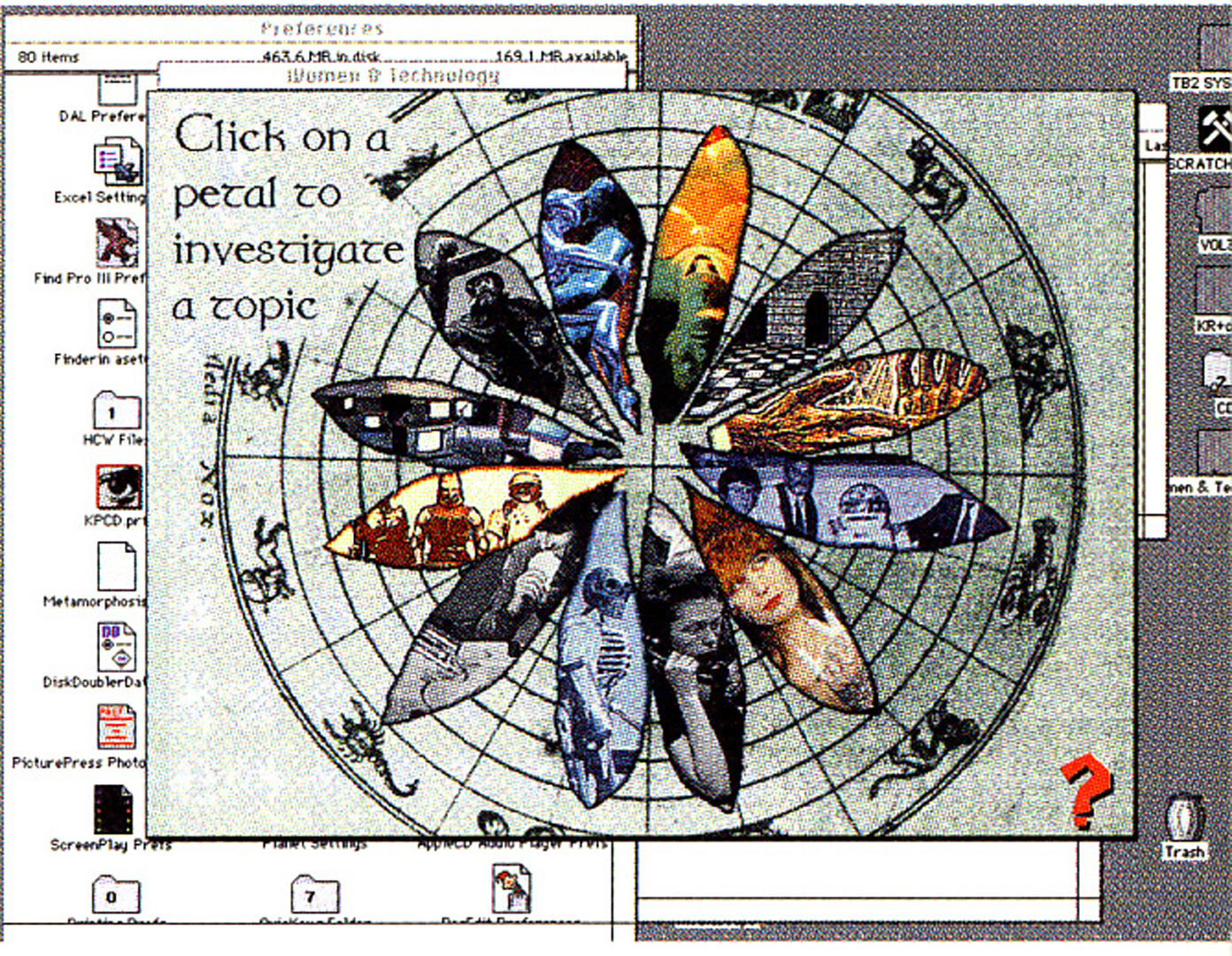Christine Tamblyn: She Loves It, She Loves It Not: Women and Technology
Title:
- She Loves It, She Loves It Not: Women and Technology
Artist(s) and People Involved:
- Christine Tamblyn
-
- San Francisco State University
Exhibiting Artist(s):
Collaborators:
Symposium:
Artist Statement:
She Loves It, She Loves It Not is an interactive CDROM disc created by Christine Tamblyn in collaboration with Marjorie Franklin and Paul Tompkins. It contains texts, sound, movie clips and images about women’s use of technology in the past, present and future. Over the last two decades feminists have identified men’s monopoly of technology as an important source of their power; women’s exclusion from access to technological prowess is a crucial element in their dependence on men. This project addresses this issue from several different angles.
The viewer accesses a series of screens by clicking a mouse. The initial interface is a graphic image of a daisy. Each of the petals of the daisy represents a loop of screens with a particular theme: Memory, Control, Power, Communication, Violence, Homunculus, Labyrinth, Interactivity, The Other, Representation and Ideology. When a viewer clicks on a petal, the loop she has chosen begins. Each screen is composed of a headline, a block of text, a static image and several “buttons” that open up to various elements. The images are derived from various found sources, including comic books, a catalog of robots, magazine advertisements and art works. The text concisely analyzes the topic from the perspectives of cultural studies, sociology and film history. A continuously looping sound is also associated with each screen. Special animated buttons allow viewers to read handwritten letters, watch Quicktime movie clips (digitized at 5 1/2 frames per second for a de-familiarizing effect) or see a “footnote” text with more detailed information about a specific topic. The text contains 84 screens and takes about an hour to view once in its entirety (in one possible configuration.) Because it is an interactive, non-linear piece, viewers can choose how long to spend with it, what order to view it in, whether to repeat or skip screens and whether or not to open buttons. The visual aesthetic of the piece has a handmade collage look; we have deliberately avoided the slick sterility of much computer art. Its content combines aspects of an academic essay or documentary film with a poetic series of associated links between graphic, film, text and sound elements. Thus,the project serves as a prototype exploring some of the new potentials of the interactive CDROM format. Both the form and the content of the work attempts to demonstrate how women might use and have used technology differently and how technology might adapt to female learning proclivities and female culture. An integral part of the project is the design of computer interfaces that are more user friendly for women. Because computers have evolved as tools built by men for men to be used in warfare, the current interfaces tend to have a violent, aggressive character. They are hierarchical, mirroring the militaristic male pyramid with its rigid chain of command.
Current interfaces also have a predominantly visual bias, privileging the male gaze and male strategies for control through surveillance of territory. Interfaces designed to be operated by women ought to be multi-sensory, personal, affective and dynamic. Our approach to redesigning the interface involves the creation of a female persona in cyberspace who serves as a guide to the system. The navigation buttons on each screen appear inside an image of this persona, and her voice gives instructions about how to proceed. By envisioning a more productive relationship between women and technology, the project will benefit women who are using new technologies in a variety of academic fields and artistic endeavors. It is designed to be exhibited as an art installation as well as to be used as an instructional resource for women students by providing positive alternatives to the negative stereotypes regarding women and technology often inculcated in early educational experiences. Just as feminist theorists have stressed the importance of women having access to the position of speaking subjects and “having a voice” in our culture, it is similarly important for
women to have role models for computer literacy as computers become an essential communications tool.
Technical Information:
The CDROM requires a high-end Macintosh computer (MAC IIci or above with 6 RAM available), a color video monitor and stereo speakers to operate. It was programmed using Macromedia Director.
Category:
All Works by the Artist(s) in This Archive:
- Christine Tamblyn
- More Art Events from Christine Tamblyn in this archive:

She Loves It, She Loves It Not: Wom...
[ ISEA94]





